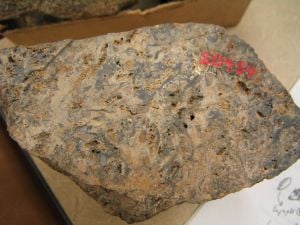Paleobotany
Paleobotany (from the Greek words paleon = old and botanikos = of herbs) is the branch of paleontology dealing with the recovery and identification of plant remains from geological contexts, and their use in the reconstruction of past environments and the history of life. A closely related field is palynology, the study of fossil and extant spores and pollen. Paleobotany includes the study of terrestrial plant fossils as well as the study of marine autotrophs, such as algae.
Paleobotany is important in the reconstruction of prehistoric ecological systems and climate, known as paleoecology and paleoclimatology respectively, and is fundamental to the study of plant development and evolution. Paleobotany has also become important to the field of archaeology, primarily for the use of phytoliths in relative dating and in paleoethnobotany,
Overview of the Paleobotanical Record
Macroscopic remains of true vascular plants are first found in the fossil record during the Silurian Period. Some dispersed, fragmentary fossils of disputed affinity, primarily spores and cuticles, have been found in rocks from the Ordovician Period of Oman and are thought to derive from liverwort- or moss-grade fossil plants (Wellman et. al., 2003).
An important early land plant fossil locality is the Rhynie Chert, an Early Devonian sinter (hot spring) deposit composed primarily of silica found outside the town of Rhynie in Scotland.
The Rhynie Chert is exceptional due to its preservation of several different clades of plants, from mosses and lycopods to more unusual, problematic forms. Many fossil animals, including arthropods and arachnids, are also found in the Rhynie Chert, and it offers a unique window on the history of early terrestrial life.
Plant-derived macrofossils become abundant in the Late Devonian and include tree trunks, fronds, and roots. The earliest tree is Archaeopteris, which bears simple, fern-like leaves spirally arranged on branches atop a conifer-like trunk (Meyer-Berthaud et. al., 1999).
Widespread coal swamp deposits across North America and Europe during the Carboniferous Period contain a wealth of fossils containing arborescent lycopods up to 30 meters tall, abundant seed plants, such as conifers and seed ferns, and countless smaller, herbaceous plants.
Angiosperms (flowering plants) evolved during the Mesozoic, and flowering plant pollen and leaves first appear during the Early Cretaceous, approximately 130 million years ago.
Notable Paleobotanists
- Kaspar Maria von Sternberg, the "father of paleobotany".
Paleobotany Textbooks
Stewart, W.N. and Rothwell, G.W. 1993. Paleobotany and the evolution of plants, Second edition. Cambridge University Press, Cambridge, UK. ISBN 0-521-38294-7
Taylor, T. N. and E. L. Taylor. 1993. The Biology and Evolution of Fossil Plants, Prentice-Hall, Inc., Englewood Cliffs, New Jersey, USA. ISBN 0-13-651589-4
External links
- International Organisation of Paleobotany
- Paleobotany Research Group, University Münster, Germany.
- The Biota of Early Terrestrial Ecosystems: The Rhynie Chert, University of Aberdeen, UK.
- The Sternberg Project
- Some historical reconstructions of plants
- Paleobotany - 1911 Encyclopaedia Britannica article
- PaleoNet - listservs and links related to paleontology
ReferencesISBN links support NWE through referral fees
- Brigitte Meyer-Berthaud, S.E. Scheckler, J. Wendt, "Archaeopteris is the Earliest Modern Tree." Nature, 398, 700-701 (22 April 1999) | doi:10.1038/19516
- Charles H. Wellman, Peter L. Osterloff and Uzma Mohiuddin, "Fragments of the Earliest Land Plants." Nature, 425, 282-285 (18 September 2003) | doi: 10.1038/nature01884
Credits
New World Encyclopedia writers and editors rewrote and completed the Wikipedia article in accordance with New World Encyclopedia standards. This article abides by terms of the Creative Commons CC-by-sa 3.0 License (CC-by-sa), which may be used and disseminated with proper attribution. Credit is due under the terms of this license that can reference both the New World Encyclopedia contributors and the selfless volunteer contributors of the Wikimedia Foundation. To cite this article click here for a list of acceptable citing formats.The history of earlier contributions by wikipedians is accessible to researchers here:
The history of this article since it was imported to New World Encyclopedia:
Note: Some restrictions may apply to use of individual images which are separately licensed.
